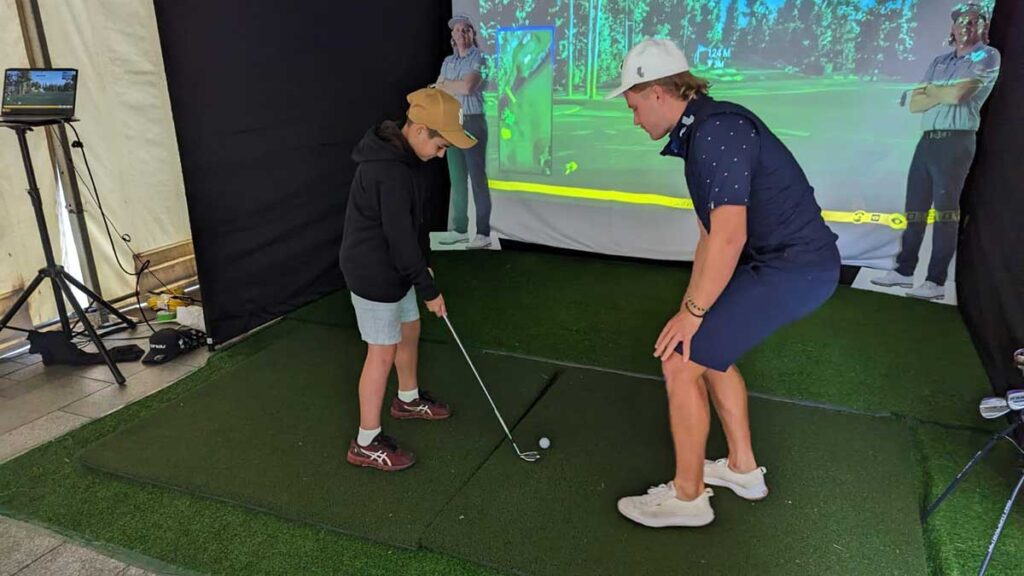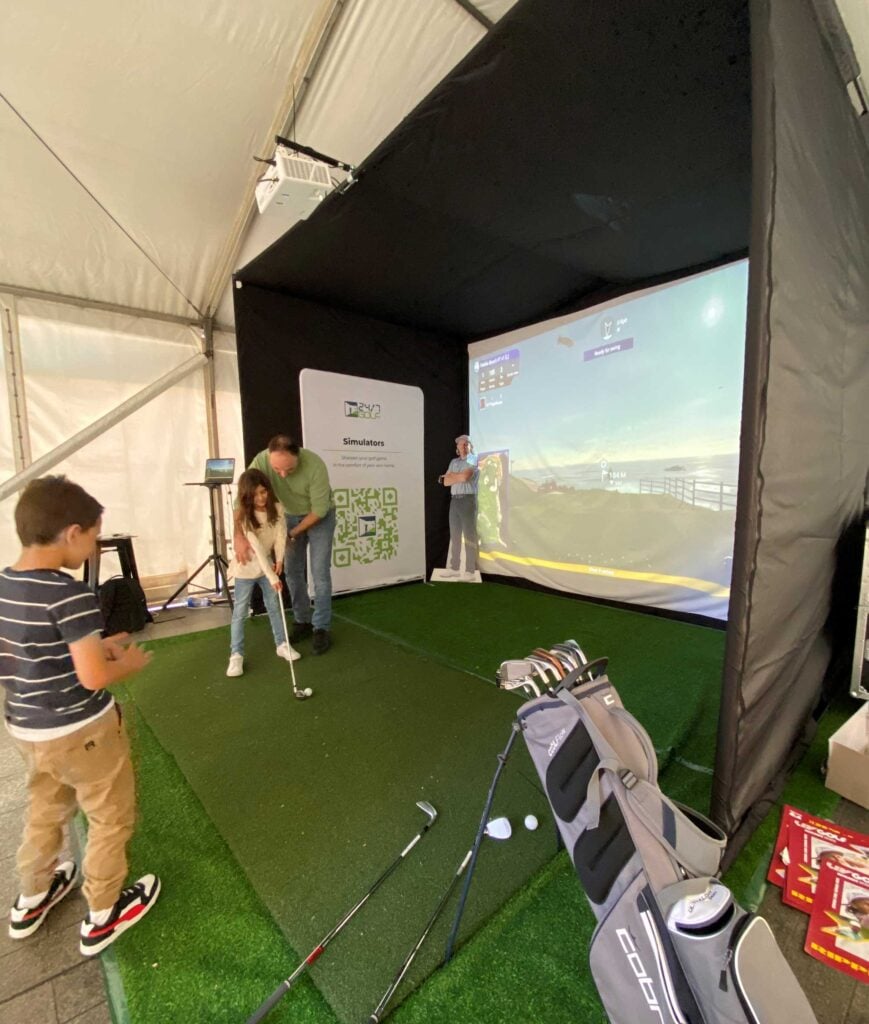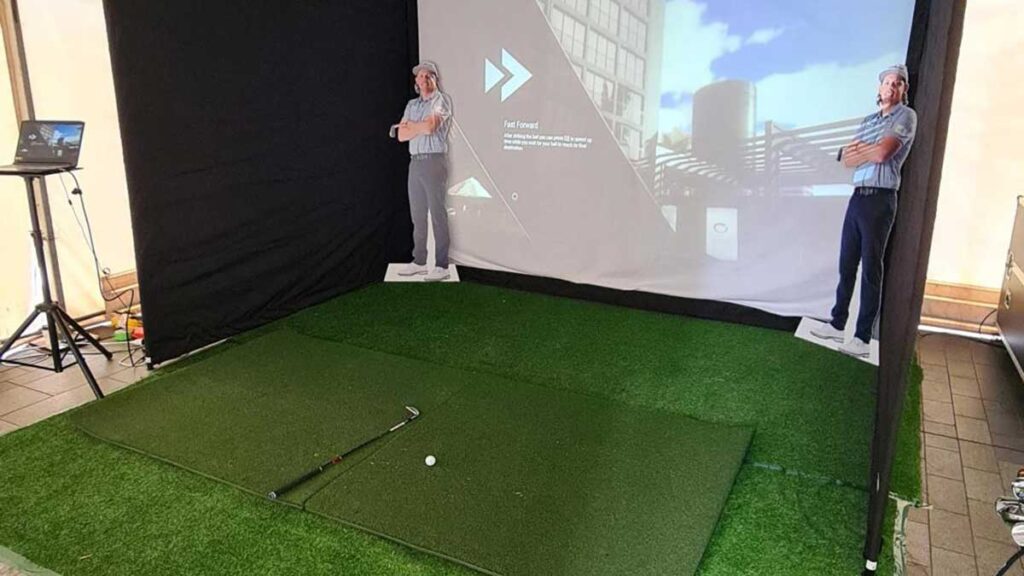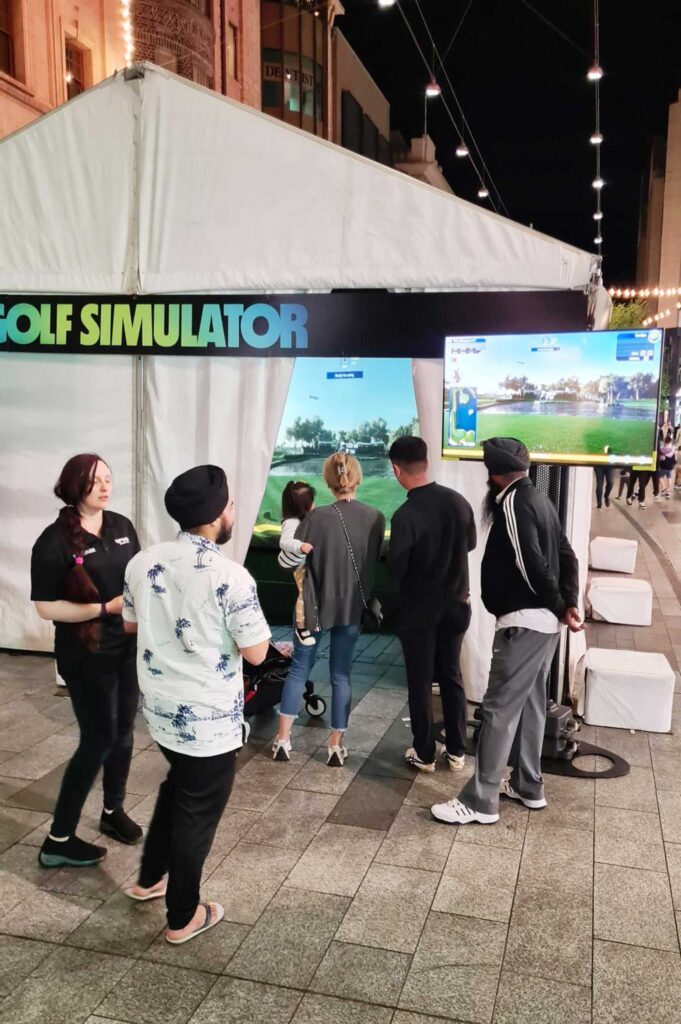It’s now easier and more affordable than ever to put a golf simulator into the home or office. Now a breakthrough in launch-monitor technology has enabled Australian manufacturer 24/7 Golf to provide shot data for rapid game-improvement
Have you ever wondered how much your golf would improve if you had one of those state-of-the-art golf simulators in your own home? Apart from where to install a simulator, inevitably comes the realisation that the cost – from $50,000 up to $120,000 for a premium fit-out – would be better spent on a home renovation.
Well, wonder no more because 24/7 Golf can build a simulator into your garage for less than $6,000. That’s with the new Rapsodo MLM2 Pro launch monitor, a projector, hitting mat and simulator-bay enclosure.

What is 24/7 Golf?
Twelve years ago, 24/7 Golf started out as a walk-in, bricks-and-mortar golf store at Burwood/Richmond in Melbourne’s inner-east. It relocated to Melbourne’s CBD to a centre with 11 indoor simulators and hitting bays. Eventually, 24/7 Golf founder Igor Vainshtein closed that centre to focus on selling SkyTrak launch monitors to practice facilities and for private use.
Born in Melbourne with a background in high-tech, Vainshtein had been a consultant for start-up companies. He soon realised he was giving away far too many valuable insights about golf simulators to online forums. Vainshtein was providing a range of tips, from what is the best screen to which parts make a good golf simulator.
Eventually he thought, I’ve got all this information. Why don’t I create a pop-up simulator-bay enclosure and piece together a good projector and hitting mat, then package it up with the launch monitors I’m selling?
Like any good entrepreneur, Vainshtein found a reliable supplier in China and started manufacturing the simulator-bay enclosures.
“Having a good golf simulator, you want to be able to provide a realistic and immersive golf experience that enables you to improve your game,” says Alistair Ferguson, general manager of 24/7 Golf (Australia).
“We package it up for $5,999 with our enclosure, hitting mat and projector. That’s going to give you a golf simulator in your home.”

What is the technology/service that makes 24/7 different?
24/7 Golf has various simulator options with regard to software, graphics, projection, enclosure-bay size and overall cost. The most affordable version ($5,999) comes with the Rapsodo MLM2 Pro launch monitor and software that lets you play more than 30,000 courses, including Royal Melbourne and Augusta National.
For gameplay, the Rapsodo MLM2 Pro software needs to be attached to either an iPad or Android device. They can be paired through an HGMI splitter that connects to the projector.
For those seeking even better graphics, the SkyTrak Play package has a laser projector and a laptop that comes installed with The Golf Club 2019, which is regarded as the premier software program for simulators with more than 170,000 golf courses.
“You can play [fourball against] people all around the world. You can play one-on-one – [strokeplay or matchplay] – it gives you great flexibility. That package comes around $12,999. So that’s our best package,” Ferguson says.

What to look for in a good golf simulator
The market for golf simulators has grown exponentially since the onset of COVID, as club membership and participation climbed during government-imposed lockdowns. However before purchasing a simulator, it’s essential to consider the accuracy of the launch monitor.
What golfers want to know is how far they hit each club in the bag. Thus, the key for golf simulators is to obtain the best spin-access readings and revolutions per minute.
The game-changer for 24/7 Golf has been the release of the Rapsodo MLM2 Pro launch monitor. It can achieve accurate readings within 1 percent accuracy of the big players in the launch-monitor market (i.e. GCQuad and GCHawk) for a fraction of the cost.
The Rapsodo MLM2 Pro retails for $1,099, compared to $15,000 for other launch monitors. At the top end, a TrackMan 4 unit costs $30,095.
Rapsodo is a US-based IT company that makes the software for the SkyTrak launch monitor. While it’s an industry veteran, Rapsodo had never previously developed hardware. Its engineers put a lot of time, effort and research into what other companies have done with their launch monitors. Then it built all those best features into one pocket-sized unit – the Rapsodo MLM2 Pro – that can be tucked into a golf bag or suitcase.
The Rapsodo MLM2 Pro is a radar-based monitor and needs to be six feet behind the hitting area, because it’s capturing data from when the ball is hit until it strikes the enclosure screen. The prime feature is the spin readings that it captures. This allows a golfer to see the ‘shot shapes’ of their particular swing.
“If you do hit a slice, it’s going to show it on the screen,” Ferguson says. “Whereas compared to one launch monitor, people have been complaining for 12 months they’re hitting push-draws but it’s not reading because the unit can’t get the spin access right based on the algorithm.”
Another design feature of the Rapsodo MLM2 Pro is how the camera records your swing and then you’re able to play it back on a smartphone or iPad. With the dual camera in the unit, it will also capture the club’s path into the back of the ball.
“It takes a video and you get to see that in real time. You can go back and review the session. It’s just an amazing feature,” Ferguson says. “For the price of the launch monitor – to be able to get those types of visual insights into your golf swing – it’s really exciting for the simulator market. And that’s why it’s making such a big noise.”

The biggest mistake when installing a golf simulator
When installing an indoor golf simulator, the first question to ask is: what are the dimensions of the room where it’s intended to be used? That tends to be a common error because people often don’t consider the highest point of the follow-through in the golf swing.
24/7 Golf has a basic set of questions to provide customers with the right information before purchasing a simulator. Once the height, width and depth of the room are known, the company can purpose-fit a simulator that will provide the best golf experience.
A feature that differentiates 24/7 Golf is the ease of setting up a simulator. Once you’ve built the enclosure, all you need to do is hook up the projector to the launch monitor (for game-improvement) or laptop (for playing the world’s best golf courses).
“You don’t have to get a builder or tradie to come in and knock up a frame and then install/mount a screen on it,” Ferguson says. “You can basically follow the instructions that we’ve got and have yourself a golf simulator within two hours.”
Another point of difference is the enclosure material. 24/7 Golf builds the ‘screen’ into the stitching of the enclosure material. The framing is click-in/click-out poles that are easy to assemble.
The enclosure comes in three different sizes: the Par 3 (3m wide x 2.6m high x 1.6m deep) has been designed for a modern garage where the standard ceiling height is 2.66 metres. The Par 4 (3.6m wide x 2.6m high x 1.6m deep) has similar dimensions.
“The unfortunate thing is you probably can’t swing driver in that height,” Ferguson says. “So it’s more for your golf fanatics that want to dial in their irons, their wedges. But you can still play simulator golf on them as well.”
From 24/7 Golf’s perspective, the Par 5 (4m wide x 3m high x 3m deep) provides the best golf-simulator experience because you can bust a driver without fear of hitting the enclosure frame. And it’s still $5,999.
